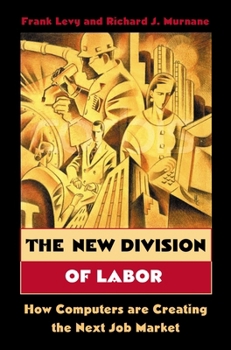The New Division of Labor: How Computers Are Creating the Next Job Market
Select Format
Select Condition 
Book Overview
As the current recession ends, many workers will not be returning to the jobs they once held--those jobs are gone. In The New Division of Labor, Frank Levy and Richard Murnane show how computers are... This description may be from another edition of this product.
Format:Hardcover
Language:English
ISBN:0691119724
ISBN13:9780691119724
Release Date:May 2004
Publisher:Princeton University Press
Length:174 Pages
Weight:1.00 lbs.
Dimensions:0.8" x 6.0" x 9.3"
Customer Reviews
4 ratings
Best book on workforce in a long time.
Published by Thriftbooks.com User , 16 years ago
If you only read one book this year, read this book. It will change the way you think about work, education and the global economy. Murnane and Levy ask two fundamental questions: What do computers do better than people? (A: rules-based thinking) What do people do better than computers? (A: pattern recognition) Much of the work of the industrial economy was rules-based, both on the assembly line and in the manager's office. Most of the work in the innovation economy is based on pattern recognition, including what Murnane and Levy call expert thinking and complex communication. Their research shows that these are the skills for which demand is growing in the economy at all rungs of the job ladder. I've found their argument so compelling that I have purchased copies of the book for most of the top policy-makers in my home state of Rhode Island. The ideas in the book are starting to shape the discussion of school reform and workforce development here. In particular, we are concerned that our school system, like those in every other state, is still producing labor for a rules-based industrial economy that no longer exists. While it's possible to absorb rules-based thinking from a book or a lecture, it's difficult to teach pattern recognition skills in a pure classroom setting. You learn to recognize patterns by actually doing it the company of someone who is already very good at it. It's the essence of good experiential learning and mentoring, which can no longer be thought of as a luxury in the education system. If we want to produce the workforce we need for an innovation economy, we'll need to make experiential learning a part of every K-12 and college experience.
A most insightful analysis of the historical labor data.
Published by Thriftbooks.com User , 19 years ago
This is a very short and easy to read book. Yet, it is very informative and insightful. I have read many books covering the same theme written by Peter Drucker, John Naisbitt, Robert Reich, and Lester Thurow among other visionaries and economists. This one is the best on the subject for two reasons. The two authors studied the historical data much more extensively than the others. Also, this book is more focused. The authors did not get sidetracked by many related economic and political issues. The authors extensive research dispels thoroughly the notion that computerization is bad for employment. To the contrary, computerization has increased both the quantity and quality of jobs. The authors studied in detail labor trends over the past 40 years to support their conclusion. They uncovered the prescient work of Herbert Simon, who wrote an essay in the 1960s on the change in labor mix with the advent of technologies. The authors documented that for the most part Simon was correct. Due to computerization, the labor mix was going to change materially over the next several decades tilted towards a greater concentration of jobs associated with greater complexity in terms of critical thinking and judgment. Just as Simon predicted, there is today a far greater percentage of the population involved in complex jobs associated with an intense critical thinking component. Such jobs include managers, professionals, technicians, and many sales related activities. By the same token, there is a far smaller percentage of the population engaged in blue collar routine work. As mentioned, just as the quality of jobs (greater complexity) has improved immensely during the past several decades, so as the quantity. Between 1969 and 2000, the labor force grew by a staggering 63% from 83 million to 135 million. And, this surge in labor occurred during the most intense computerization era. If we just observe the change in our own working lives, we can confirm that our job functions have changed dramatically for the better. We all use computers with increasingly powerful hardware that can handle increasingly complex software. In turn, the software replaces many of the routine components of our jobs. It also gives us quick access to a math level which would have been accessible only to PhDs not long ago. I don't think any of us would readily turn the clock back on computerization regarding our specific jobs. The authors will convince you the same is true at the macroeconomic level.
Effortless Learning
Published by Thriftbooks.com User , 19 years ago
A wonderful quick read, a painless injection of knowledge, letting those of us who never got beyond Econ 1-a understand the revolutionary impact of computers on American society. Not all a bed of roses -- we face the troublesome specter of our own version of Benjamin Disraelli's Victorian "two nations," with a growing gap between those at the bottom and the rest of society.
A must read for Employment Professionals
Published by Thriftbooks.com User , 19 years ago
I highly recommend this book to job counselers, educators, and HR professionals. It also would be useful to general managers. It provides empirical data on what is really going on in today's workplace and gives incite into what can be done to address job issues. Chet Terry Retired HR Professional




